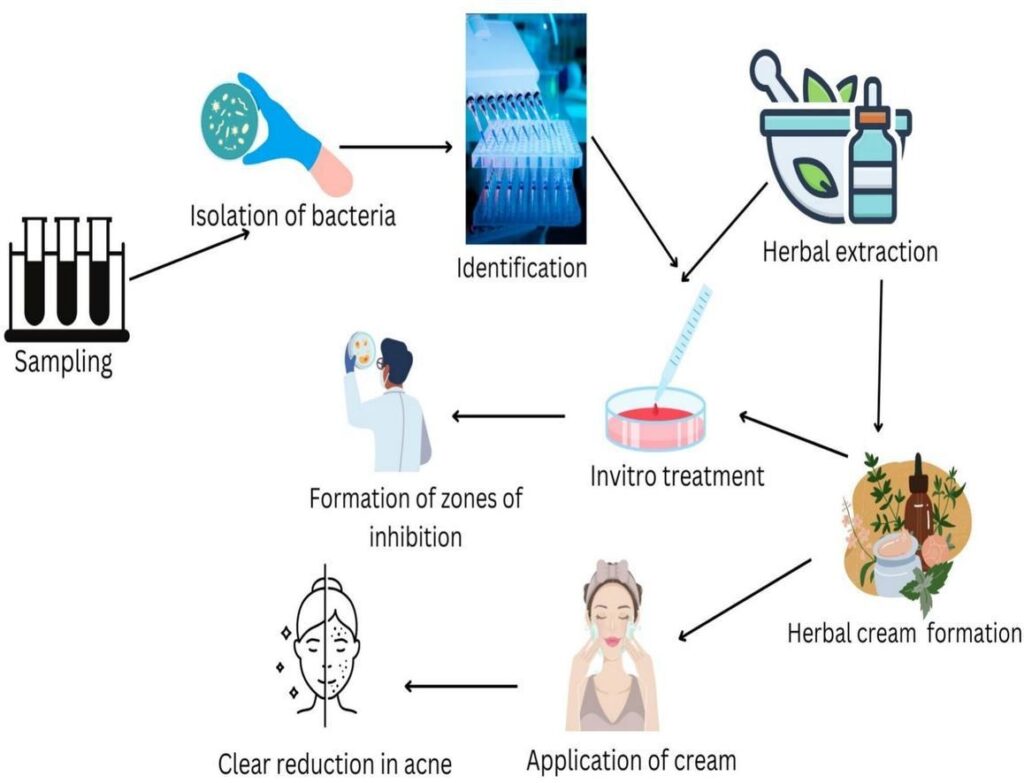Acne is a pervasive skin disorder linked to the pilosebaceous components of the skin (hair follicles and oil glands). It manifests clinically through seborrhea and inflammatory or non-inflammatory lesions, often resulting in scarred skin. Acne is highly prevalent among adolescents, peaking at 35% in 17- to 20-year-old boys and 41% in 13- to 18-year-old girls. The condition is multifactorial, driven by hormonal changes, genetics, environmental factors, and particularly, the activity of the skin microbiome. Key microbial culprits in acne pathogenesis include Propionibacterium acnes (now Cutibacterium acnes) and various Staphylococcus species (such as S. epidermidis and S. aureus).
The conventional treatment of acne often relies on allopathic drugs, which can be associated with side effects. This reality has driven increased interest in utilizing natural therapies . Herbal and fruit extracts are considered a promising alternative due to their perceived safety and documented therapeutic potential, possessing properties such as antibacterial, anti-inflammatory, and antioxidant activities. The present research was conducted to evaluate the antibacterial efficacy of selected herbal and fruit ethanolic extracts in vitro against acne-related bacteria, building upon prior research demonstrating the effectiveness of active constituents found in plant extracts for potential topical application.
Methods
Acne samples were collected from teenagers (aged 15 to 19) and six bacterial strains, including Cutibacterium acnes and various Staphylococcus species, were identified through biochemical and 16S rRNA gene sequencing methods. Ethanolic extracts of nine sources—five herbs (neem, tulsi, liquorice, turmeric, amaltas) and four fruits (sweet lime, banana, pomegranate, lemon)—were prepared and assessed for antibacterial efficacy using well and disc diffusion assays. The most active extracts underwent GC-MS analysis to identify key phytochemical components, such as mahanimbine and hydroxymethylfurfural. Finally, two anti-acne cream formulations (Formulation A: herbal-based; Formulation B: fruit-based) were developed using the extracts and subsequently tested for their antibacterial capacity in vitro.
Key Findings
• Six acne-related bacterial strains were isolated and molecularly characterized: Staphylococcus sp. (S1), Cutibacterium acnes (S2), Staphylococcus aureus (S3), Staphylococcus epidermis (S4), Bacillus paramycoides (S5), and Mammalicoccus lentus (S6).
• Among all tested extracts, neem (Azadirachta indica) and pomegranate (Punica granatum) extracts demonstrated the most effective antibacterial activity, confirmed by significant inhibition zones and ANOVA analysis.
• Pomegranate extract exhibited the largest inhibition zones against Staphylococcus sp. and S. aureus in the well diffusion assay. In the disc diffusion assay, pomegranate also showed the highest overall zones of inhibition.
• Liquorice (Glycyrrhiza glabra) demonstrated the least efficacy among the tested extracts.
• GC-MS analysis identified potent bioactive compounds: mahanimbine (a carbazole alkaloid with anti-inflammatory and antibacterial properties) was highly concentrated in neem, and hydroxymethylfurfural (with antimicrobial activity) was detected in pomegranate and tulsi.
• The formulated creams showed substantial antibacterial profiles against all six strains. Formulation A (based on neem, tulsi, liquorice root, and Aloe vera) was significantly more effective than Formulation B.
• Formulation A demonstrated the highest inhibition against Staphylococcus sp. (37.67 mm) and C. acnes (37.66 mm), suggesting a strong synergistic effect among its herbal ingredients (antimicrobial neem/tulsi and anti-inflammatory licorice/aloe vera).
• Application of the laboratory-prepared cream resulted in a significant reduction of acne growth in human subjects over 7 days of regular use.
This research successfully demonstrated the potent anti-acne potential of natural extracts, identifying neem and pomegranate as highly effective antimicrobials against common acne-associated bacterial strains in vitro . The novelty of this research lies in the detailed molecular characterization of the acne isolates and the subsequent incorporation and testing of these plant extracts into effective, safety-confirmed cream formulations (Formulations A and B), confirming the utility of plant-based compositions as a viable intervention for acne treatment. The GC-MS data further supports the medicinal value by correlating antibacterial activity with specific bioactive components like mahanimbine and hydroxymethylfurfural.
The future implication of these findings is the suggested shift toward polyherbal preparations for topical acne treatment . Since the preliminary results confirm the possible use of these plant-based compositions in acne therapy, the study strongly recommends that further in vivo experiments and clinical observations be performed to confirm the full therapeutic possibilities and establish the long-term clinical effectiveness of these herbal formulations.
Link to the study: https://tinyurl.com/4aht8x6r


